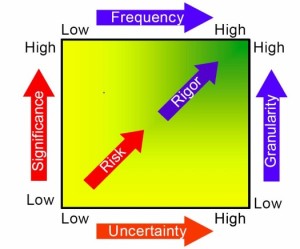Over the last few weeks, I’ve seen more rubbish published about CPM from supposed experts than usual. The false assertions range from statement claiming CPM does not include resource analysis to ones confusing basic resource scheduling processes.
So here are a few supported facts:
- The Critical Path Method (CPM), and PERT (Program Evaluation and Review Technique) both started out as ‘activity-on-arrow’ networks in 1957. The Precedence Diagramming Method (PDM) uses an activity-on-node’ notation, and was published in 1962 as a manual technique but was quickly applied to both PERT and CPM networks by the computer companies developing CPM and PERT software (by 1965 everything had merged into ‘all encompassing’ software packages). See: https://mosaicprojects.com.au/PMKI-ZSY-030.php
- The two fundamental differences between CPM and PERT are:
- CPM uses a single deterministic duration estimate, PERT uses three duration estimates and is used to assess the probability of achieving a milestone.
- CPM was built to resolve resourcing issues on plant shutdowns for Du Pont, PERT/Time did not include resources until the introduction of PERT/Cost in 1961. PERT/Cost used a single resource estimate. See: https://mosaicprojects.com.au/PMKI-ZSY-020.php#EVM
- Resource analysis uses time analysis calculations as a basis for its resource calculations:
- Aggregation: sums the resource requirements per day based on time analysis dates (usually early start)
- Smoothing: levels resource demand by using the available float. Some resource overloads will be reduced or eliminated by using float to shift non-critical activities back in time. The project end date and other constraints do not change, which means in some situations resource overloading may still occur.
- Leveling: delays critical tasks and the project completion to avoid overloading. See:
https://mosaicprojects.com.au/PMKI-SCH-013.php#Process5
The ‘lean construction’ salesmen promoting the lie CPM does not include resources are simply wrong. What is true are a lot of schedulers develop schedules without resources, resource balancing in a CPM schedule is difficult, and there are now better options for resource optimization available in some tools. But many contracts and the USA GAO require resource loaded schedules. Similarly, there are a number of ‘experts’ confusing resource smoothing and levelling (there seems to be quite a few). To correct their error, all they need to do is simply read a standard – the PMBOK® Guide (6th Ed.) is a good starting point and is consistent with all other credible authorities for the last 50+ years.
- The purpose of a CPM schedule is also confused by many experts. Every schedule is a simple model of how work on a project may unfold in the future. This means the schedule cannot be completely accurate:
- The schedule is a simplified representation, it contains a few hundred, or thousand activities that summarize the millions of actions that the project team will actually do to complete the work.
- The schedule modeling process is simplistic and prone to error, see: /2022/06/08/cpm-anomalies-invalidate-monte-carlo/
- Every duration and resource estimate is an assessment of what may happen in the future. The unknown is the degree of error in each estimate, and overall.
- The project team may, or may not, follow the planned sequence of work.
So, what’s the point of developing a schedule? As Prof. George Box pointed out in “Time Series Analysis – Forecasting and Control” (page 285): “All models are approximations, and no model form can ever represent the truth absolutely. Given sufficient data, statistical tests can discredit models that could nevertheless be entirely adequate for the purpose at hand. Alternatively, tests can fail to indicate serious departures from assumptions because of small sample sizes or because these tests are insensitive to the types of discrepancies that occur. The best policy is to devise the most sensitive statistical procedures possible but be prepared to employ models that exhibit slight lack of fit. If diagnostic checks, which have been thoughtfully devised, are applied to a model fitted to a reasonably large body of data and fail to show serious discrepancies, then we should feel comfortable using that model.” This and a number of similar quotes by him are often paraphrased as ‘All models are wrong, but some are useful’. A well-constructed CPM schedule can be extremely useful if it is used to:
- Obtain agreement from the project team and resource suppliers on how the work will be done,
- For assessing risk and identifying issues early,
- Measuring performance against the plan and identifying variances,
- Testing options to overcome negative variances and then obtaining buy-in to implement the recovery action.
But the CPM schedule will only be useful, if it is used by the project team to communicate, agree, and coordinate their work. The bigger the project, the more important this communication, agreement, and buy-in becomes. This is a dynamic, adaptive, agile, process. Focusing on what was thought to be a good idea last year embedded in a fossilized ‘contact program’ that does not change may keep claims consultants in a job, but it won’t help finish the project on time. If the schedule is not working on your project, it is a management and skills issue, changing to a different tool will not solve either of these factors.
One of my objectives in publishing Easy CPM was to make a low cost, easy-to-read resource available to schedulers who want to lift their skills – fixing management is a more interesting challenge. For more on Easy CPM see: https://mosaicprojects.com.au/shop-easy-cpm.php.
Finally, to answer the last question, borrowing from Group Captain Sir Douglas Bader: “Schedules are for the guidance of wise people and the obedience of fools!” They provide insight, not control, and can be extremely useful if they are used!






